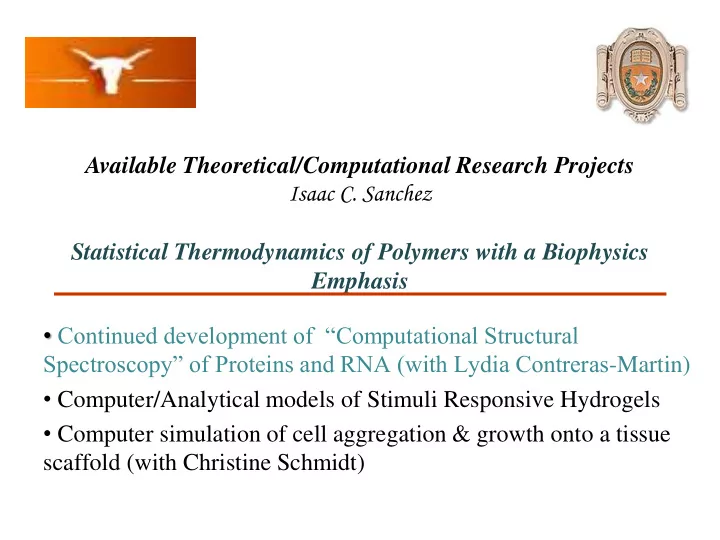

Available Theoretical/Computational Research Projects Isaac C. Sanchez Statistical Thermodynamics of Polymers with a Biophysics Emphasis • Continued development of “Computational Structural Spectroscopy” of Proteins and RNA (with Lydia Contreras -Martin) • Computer/Analytical models of Stimuli Responsive Hydrogels • Computer simulation of cell aggregation & growth onto a tissue scaffold (with Christine Schmidt)
Computat atio ional nal Structural ctural Spectros troscopy opy (CSS) A new Monte Carlo method, based on the potential energy landscape of a globular protein, can characterize the void structure within a protein. This algorithm produces a characteristic “spectrum” for the cavity size distribution as well as a size spectrum of percolating and non-percolating paths through a protein. For many proteins, it is widely believed that void structure plays an important role in function. Future objectives: Map out optimal diffusion pathways for ions (e.g., Ca ++ ) and gas molecules such as O 2 and CO 2 within the void structure of a globular protein. Provide computer visualizations of protein void structure.
CSS of an amorphous polymer [ Polymer , 52 , 2244-2254, 2011]
Folding ding a Polyme mer Chain n into o a Simulati ation on Box
Structure of Aquaporin 2C32
Cavity Size Distribution in Aquaporin
Percolation Path (Span) Spectrum for Aquaporin
Available Theoretical/Computational Research Projects Isaac C. Sanchez Statistical Thermodynamics of Polymers with a Biophysics Emphasis • Continued development of “Computational Structural Spectroscopy” of Proteins and RNA (with Lydia Contreras -Martin) • Computer/Analytical models of Stimuli Responsive Hydrogels • Computer simulation of cell aggregation & growth onto a tissue scaffold (with Christine Schmidt)
Micrograph of a hydrogel Micro-pores can open and close with changes in pH, salinity , specific ions, pressure, temperature, etc.
Mo Moti tivation vation Analytical/computer modeling the contraction-expansion mechanism of hydrogels for drug delivery applications
The Dream Stimuli responsive hydrogels can be made to be target specific. Imagine delivering a drug imbibed in a micro-gel particle via the blood stream to a diseased body part or organ. On arrival the gel interacts with the diseased cells releasing the drug while the gel safely dissolves.
Available Theoretical/Computational Research Projects Isaac C. Sanchez Statistical Thermodynamics of Polymers with a Biophysics Emphasis • Continued development of “Computational Structural Spectroscopy” of Proteins and RNA (with Lydia Contreras -Martin) • Computer/Analytical models of Stimuli Responsive Hydrogels • Computer simulation of cell aggregation & growth onto a tissue scaffold (with Christine Schmidt)
Hydrogels from the Schmidt lab as potential tissue scaffolds
Computer model for cell development in tissue scaffold Determine the conditions that promote cell adhesion to the tissue scaffold. A minimalist model is characterized by only 4 parameters: a cell size parameter, 2 parameters that measure the strength of cell- cell and cell-wall interactions, and a viscous drag parameter that determines the work energy required to move a cell through a viscous medium. Some variables that can be externally controlled are the surface-to-volume ratio of the porous scaffold, cell number density, and cell medium viscosity .
Selected Recent Publications • “ Gas Diffusion in Glasses via a Probabilistic Molecular Dynamics” F. T. Wilmore and I. C. Sanchez, J . Chem. Phys . 126 , 234502 (2007) • “On the Asymptotic Properties of a Hard Sphere Fluid,” I. C. Sanchez and J. S. Lee, J. Phys. Chem. B , 113 , 15572-15580, (2009) • “Pressure Effects on Polymer Coil - Globule Transitions near an LCST” D. S. Simmons and I. C. Sanchez, Macromolecules 43 , 1571 – 1574 (2010). • “Conductivity Mechanisms in a Composite of Chitosan -Silver Nanoparticles ,” E. Prokhorov, et. al ., Mol. and Liq. Crystals, 536, 24-32, (2011). • “ Cavity Size, Sorption, and Transport Characteristics of Thermally Rearranged Polymers , Y. Jiang, et. al ., Polymer , 52 , 2244-2254 (2011) • “Entropy of Living versus Non - living Systems,” I. C. Sanchez, J. Mol. Phys., 2 , 654-57 (2011).
Recommend
More recommend